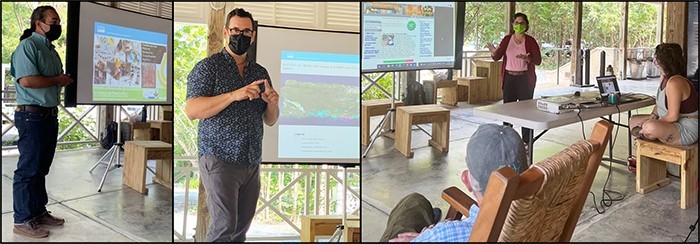|
Producers with farmers.gov accounts can now access farm records and maps online, the latest self-service feature added to the U.S. Department of Agriculture (USDA) website.
You can quickly and easily access your land information in real time by desktop computer, tablet or phone. Capabilities include:
- View, print and export detailed farm records such as cropland, base acres, yields, CRP acres, land ownership details, and much more;
- View, print and export farm/tract maps that can be provided to lenders, chemical or fertilizer providers, and FSA for reporting acreage and crop insurance agents; and
- Export common land unit (field) boundaries as ESRI shapefiles.
The ability to access these records on demand without a visit to the service center saves you time and money.
Farmers.gov now includes the most popular functionalities from FSAFarm+, the FSA portal for producers, while providing enhanced functionality and an improved user experience. A new enhancement expands the scope of accessibility to include farmers and ranchers who are members of an entity, as well as people with a power of attorney form (FSA-211) on file with FSA.
Managing USDA Business Online
Using farmers.gov, producers, entities and those acting on their behalf can also:
- View, upload, download, and e-sign conservation documents.
- Request financial assistance, including submitting a program application.
- View and submit conservation requests.
- View technical references and submit questions.
- Access information on current and past conservation practices, plans and contracts.
- Report practice completion and request practice certification.
- View farm loan and interest information (producers only).
Future plans include adding the ability to import and view other shapefiles, such as precision agriculture planting boundaries.
To access your information, you’ll will need a USDA eAuth account to login to farmers.gov. After obtaining an eAuth account, producers should visit farmers.gov and sign into the site’s authenticated portal via the Sign In/Sign Up link at the top right of the website. Google Chrome, Mozilla Firefox or Microsoft Edge are the recommended browsers to access the feature.
In addition to the self-service features available by logging into farmers.gov, the website also has ample information on USDA programs, including pandemic assistance, farm loans, disaster assistance, conservation programs and crop insurance. Recently, USDA updated the navigation and organization of the site as well as added some new webpages, including “Get Involved,” “Common Forms,” and “Translations.” Learn more about these changes.
^ back to top
FSA is cleaning up our producer record database and needs your help. Please report any changes of address, zip code, phone number, email address or an incorrect name or business name on file to our office. You should also report changes in your farm operation, like the addition of a farm by lease or purchase. You should also report any changes to your operation in which you reorganize to form a Trust, LLC, or other legal entity.
FSA and NRCS program participants are required to promptly report changes in their farming operation to the County Committee in writing and to update their Farm Operating Plan on form CCC-902.
To update your records, contact your St. Croix County USDA Service Center at (340) 773-9146 ext. 100.
^ back to top
Farmers can use USDA farm ownership microloans to buy and improve property. These microloans are especially helpful to beginning or underserved farmers, U.S. veterans looking for a career in farming, and those who have small and mid-sized farming operations.
Microloans have helped farmers and ranchers with operating costs, such as feed, fertilizer, tools, fencing, equipment, and living expenses since 2013.
Microloans can also help with farmland and building purchases and soil and water conservation improvements. FSA designed the expanded program to simplify the application process, expand eligibility requirements and expedite smaller real estate loans to help farmers strengthen their operations. Microloans provide up to $50,000 to qualified producers and can be issued to the applicant directly from the USDA Farm Service Agency (FSA).
To learn more about the FSA microloan program, contact your St. Croix County USDA Service Center at 340-773-9146 ext. 100 or visit fsa.usda.gov/microloans.
^ back to top
Healthy soils are a key to a healthy life. Every Dec. 5th NRCS Caribbean Area joins people around the globe to celebrate World Soil Day to recognize the importance of sustaining healthy ecosystems through better management of the world’s soil resources. On Saturday, Dec. 4 our NRCS Caribbean Soils Team participated in “Arte del Suelo” Educational Conference in celebration of World Soil Day. This year’s theme was “Reclamar el Suelo, Declamar la Tierra” (Reclaim the Soil, Declare the Earth). State Scientist Manuel Matos (below left), MLRA Soil Survey Leader Samuel Rios (below center), and Resource Soil Scientist Lizandra Nieves (below right) discussed the history and development of Puerto Rico's Soil Surveys with about 12 participants at the Las Cabezas de San Juan Nature Reserve in Fajardo, 5 participants via Zoom and broadcast online on FaceBook Live. Learn more about Caribbean Soils...
^ back to top

Our NRCS conservation planners are continually updating their knowledge and skills to use science-based technology, tools, and applications to provide sound natural resources conservation assistance to our Caribbean Area farmers. From Nov 29 - Dec. 3, 2021, NRCS Caribbean Area held a week-long Conservation Planner Training in St. Croix, USVI, to train our team and partners on the agency’s newest techniques and updated practices.
Throughout the week our planners spent half the day in the classroom and the rest of the day conducting field assessments – refreshing their skills and learning new tools for our 9-step Conservation Planning Process. These steps provide the foundation for the advice NRCS conservationists give our farmers to help them select the best combination of conservation practices to meet their natural resource needs and individual farm management goals.
Our planners applied classroom lessons in the field, using digital tools and developing alternatives to present to the class. On the fifth and final day of the training, our Planners made their final project presentation. Photos below (left to right): Conservationists receive cultural resources training from Archaeologist Marinés Colón-González; Conservationists Faye Williams & Rudy O’Reilly Jr. take measurements in the field; Biologist Ricardo Colón discusses wildlife habitat resource concerns with trainees.
^ back to top


NRCS can help farmers and forest landowners to conserve pollinators, wildlife and forest ecosystems through our Wildlife and Forestry Initiatives. Applying conservation practices on your land will benefit native plants and animals that will provide you ecosystem services like pest control, soil fertility and clean water. Some conservation practices that you can use to improve biodiversity are: Structures for Wildlife, Hedgerow Planting, Wildlife Habitat Planting, Upland and Wetland Wildlife Habitats Management, Riparian Forest Buffers, Silvopasture, Forest Stand Improvement, Multi-story Cropping, and Tree/shrub Establishment.
Healthy pollinators and wildlife habitats are essential for agricultural resilience and sustainability. Forest improvement is possible and can help preserve your agri-business by increasing profit and reducing the impacts of natural disasters like drought and storms. Want to learn more about what to do on your farm? Contact your local NRCS Field Office for more information.
^ back to top
|
USDA announced that seven rural projects in Puerto Rico will split $500,000 in grant funding from the Rural Energy for America Program (REAP) to reduce the impacts of climate change on those communities. The selected projects across the island were:
-
San Pedro Pharmacy of Lajas (Cortes-Lebron Family): awarded $56,760 to purchase a renewable energy system and develop energy efficiency improvements to their operation to save ~$41,414 per year in energy costs.
-
Hatillo Cash & Carry Inc.: awarded $259,010 to install a 1.17-megawatt renewable energy system to help them save ~$398,370 in energy costs annually, enough energy to power 175 houses.
-
C&C Petroleum Inc.: a small gasoline station in Juncos, awarded $49,387 to purchase and install a solar energy system estimated to save $20,793 per year in energy costs.
-
A García & Company Inc.: a small hardware wholesaler in Arecibo, awarded $42,500 to purchase and install a renewable energy system estimated to save $28,701 per year.
-
Avicola Santos Inc.: a small poultry Farm in Aibonito, awarded $41,343.
-
Best Work Construction in San Lorenzo awarded $34,000.
-
Liselie Reyes-Martinez, who runs a dental clinic in Barceloneta, awarded $17,462.
USDA is granting a total of $668 million nationwide to fund 1,141 projects through different agency programs. Learn more…
^ back to top
|